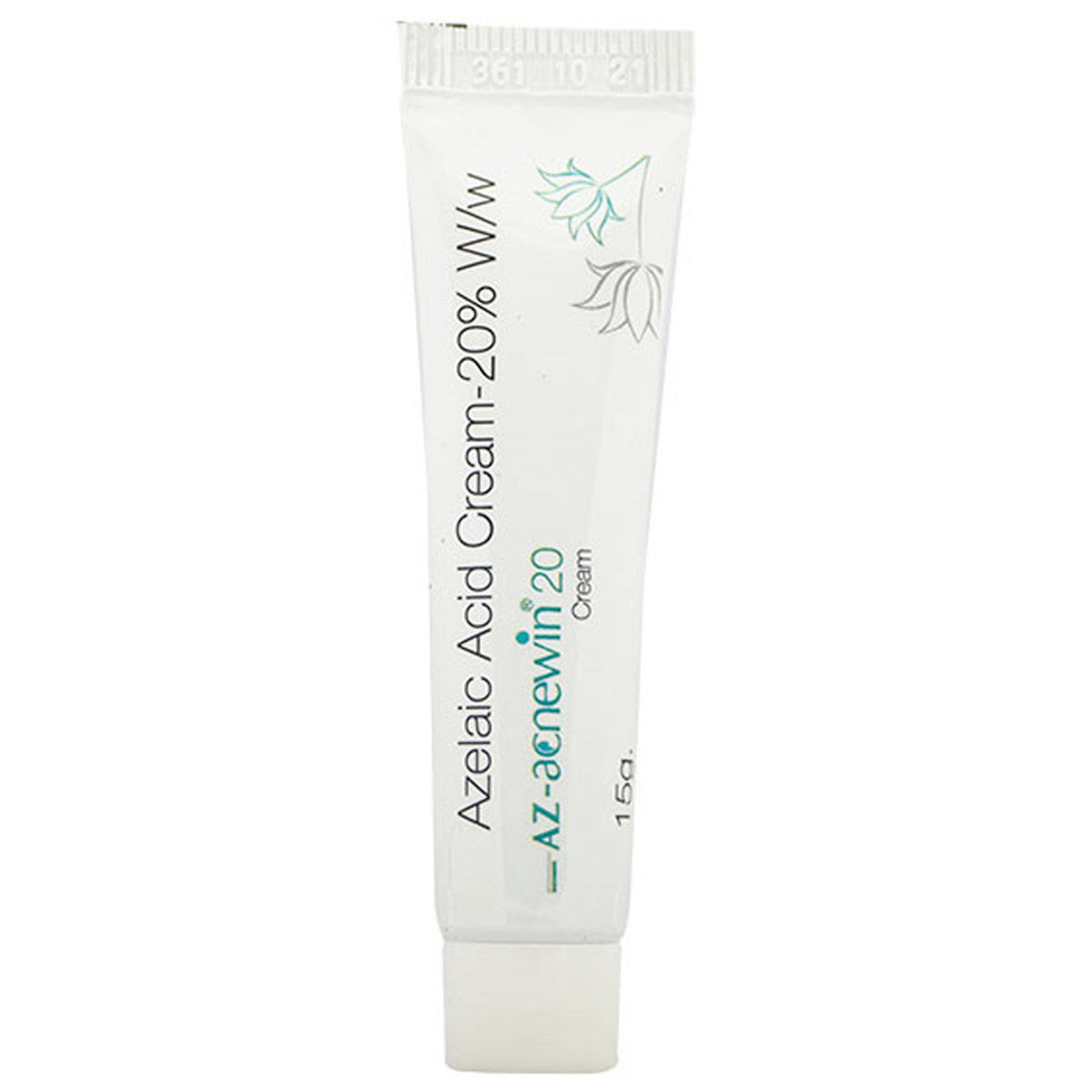Azelaic Acid
About Azelaic Acid
Azelaic Acid is used to treat red, swollen acne spots (like papules and pustules) and to reduce facial redness and bumps caused by rosacea. Acne is a skin condition caused when the hair follicles are plugged with oil and dead skin cells. It can cause whiteheads, blackheads and pimples. Rosacea is a skin disease that causes redness, flushing, and pimples on the face.
Azelaic Acid contains 'Azelaic acid,' which is a bactericidal (kills bacteria) agent. It is a naturally occurring aliphatic dicarboxylic acid that helps stop the growth of acne-causing bacteria and reduces keratin production, which helps prevent the formation of comedones (clogged pores).
Azelaic Acid is for external use only. Avoid contact with eyes, eyelids, lips, mouth and nose. If the medicine comes into contact with any of these areas, rinse the area immediately with water. Common side effects of Azelaic Acid include dryness, peeling, burning, irritation, itching and dermatitis. These side effects may not occur in every patient using this medication and may differ individually. If the side effects persist longer or worsen, please seek a doctor’s advice.
If you are allergic to Azelaic Acid or any other medications, inform your doctor. If you are pregnant or breastfeeding, it's important to consult your doctor before using Azelaic Acid. Avoid using Azelaic Acid in excessive doses or for prolonged periods, as this may lead to adverse effects. Do not apply Azelaic Acid to open wounds, cuts, scrapes, or damaged skin. Azelaic Acid may make asthma worse. Consult your doctor if your asthma worsens while using Azelaic Acid.
Uses of Azelaic Acid
• Treatment of papulopustular rosacea: Reduces the inflammatory papules and pustules associated with mild to moderate rosacea.
• Relief from papulopustular acne: Treats mild to moderate acne with inflammatory pimples and pus-filled areas.
• Reduction of skin redness: Reduces visible redness and irritation associated with rosacea and acne.
• Antibacterial action: Azelaic Acid kill bacteria on the skin that contribute to acne and rosacea flare-ups.
• Improves skin clarity: Promotes clearer, smoother skin by reducing pore blockage and inflammation.
Medicinal Benefits
Azelaic Acid treats acne (pimples) and rosacea (redness and visible blood vessels on the face). It contains 'Azelaic acid', a dicarboxylic acid with antibacterial, keratolytic, comedolytic (inhibiting the formation of blemishes), and antioxidant activity. Azelaic Acid is bactericidal and inhibits the synthesis of microbial cellular proteins. It clears the pores of bacteria that cause irritation and breakouts.
Directions for Use
- Follow your doctor's instructions on the dosage and timing of this medication to ensure safe and effective use.
- Take the advised amount of Azelaic Acid and apply it as a thin layer on the clean and dry affected area as prescribed by your doctor.
- Azelaic Acid is for external use only. Avoid contact with the eyes, ears, nose, and mouth. If Azelaic Acid comes into contact with the eyes, nose, or mouth, rinse with water immediately.
Storage
Side Effects of Azelaic Acid
- Dryness
- Peeling
- Burning
- Irritation
- Itching
- Dermatitis
Drug Warnings
Do not use Azelaic Acid if you are allergic to Azelaic Acid or any of its components. Please inform your doctor if you are using any prescription and non-prescription medications you are taking, including vitamins, before starting Azelaic Acid. Azelaic Acid can make the skin change colour, especially when the skin is dark in colour. It is recommended to avoid tanning booths and sunlamps. Do not apply Azelaic Acid to the irritated and sunburned skin. Please limit the use of products that contain large amounts of alcohol (astringents, shaving creams or after-shave lotions), hair removal products, and products containing lime or spices while using Azelaic Acid. Pregnant and breastfeeding women should consult their doctor before using Azelaic Acid.
Drug Interactions
Drug-Drug Interaction: No interactions found.
Drug-Food Interaction: No interactions found.
Drug-Disease Interaction: Before starting Azelaic Acid, let your doctor know about your previous medical history, including skin infections.
Drug-Drug Interactions Checker List:
Safety Advice

Alcohol
consult your doctorThe interaction of Azelaic Acid with alcohol is unknown. Please consult your doctor in case of any concerns.

Pregnancy
consult your doctorPlease consult your doctor before using Azelaic Acid if you are pregnant or planning to conceive.

Breast Feeding
consult your doctorThere are limited studies on how Azelaic Acid affects breastfed infants. Please consult your doctor before using Azelaic Acid if you are breastfeeding. If you need to apply Azelaic Acid on your breasts, don't do this shortly before giving a feed.

Driving
not applicableAzelaic Acid usually does not interfere with your driving ability and is safe to use.

Liver
consult your doctorLet your doctor know if you have any history of liver disease before using Azelaic Acid.

Kidney
consult your doctorLet your doctor know if you have any history of kidney disease before using Azelaic Acid.

Children
cautionAzelaic Acid is not recommended for use in children as the safety and efficacy is not established.
Habit Forming
Diet & Lifestyle Advise
- Avoid harsh products on your skin.
- Do not share cosmetic products, face towels, and bathing bars.
- Manage stress, eat healthily, drink plenty of water, exercise regularly, and get plenty of sleep.
- Avoid or limit the intake of alcohol and caffeine.
- Rinse your face with water several times a day to avoid breakouts.
- Do not scratch or pick your skin to avoid infecting the affected area.
- Hydration is important in managing acne; hence, drink 3-4 litres of water daily to eliminate toxins from the body.
- Include anti-inflammatory foods in your diet.
Special Advise
Consult your dermatologist if you do not notice any improvement after 4-6 weeks of treatment with Azelaic Acid.
Patients Concern
Disease/Condition Glossary
Acne: Acne vulgaris is a skin condition caused when the hair follicles are plugged with oil and dead skin cells. Whiteheads, blackheads, pimples, cysts, and nodules are all types of acne. It commonly occurs in teenagers, although all age groups are affected. Symptoms include blackheads, pus-filled pimples, and large/red bumps. Break-outs can happen on the face, neck, back, shoulders, and chest. The risk factors for acne are hormonal changes, polycystic ovarian syndrome (PCOS), poor sleep, stress, smoking, dermatological and cosmetic products with high oil content, and genetic conditions. Treatment involves antibiotics, retinoids, and topical products with diet and lifestyle changes.
Rosacea: Rosacea is a chronic skin condition that primarily affects the face. It causes redness, tiny visible blood vessels, and red lumps that resemble pimples. It typically appears on the cheeks, nose, chin, or forehead and might come and go over time.
FAQs
Azelaic Acid is used for the treatment of mild to moderate papulopustular acne and papulopustular rosacea on the face.
Azelaic Acid contains 'Azelaic acid,' which is a bactericidal (kills bacteria) agent. It is a naturally occurring aliphatic dicarboxylic acid that helps stop the growth of acne-causing bacteria and reduces keratin production, which helps prevent the formation of comedones (clogged pores).
Your doctor may advise the initial dose as once daily in the evening. The dose may be increased to twice or thrice daily in the morning and evening.
Azelaic Acid usually improves your skin condition in four weeks of treatment. If you notice no improvement after a month of treatment, please reach out to your doctor. For best results, the doctor may advise you to use Azelaic Acid regularly for several months.
It is advised to limit the use of products that contain large amounts of alcohol (astringents, shaving creams or after-shave lotions), hair removal products, and products containing lime or spices if you are using Azelaic Acid.
It is not recommended to use Azelaic Acid for the treatment of melasma. Azelaic Acid is only useful in treating acne, rosacea and its associated conditions.
The amount of Azelaic Acid you should apply is determined by the region of your skin prone to acne. Your physician or dermatologist may advise you on how much to take.
Apply the advised amount with clean and dry hands to the skin's affected areas. Gently massage the medicine into the skin with your fingers. Wash your hands before and after applying. Do not put dressing or bandage on the affected areas.
It's generally recommended to use Azelaic Acid for several weeks or months after your acne clears to prevent recurrence.
Common side effects of Azelaic Acid include dryness, peeling, burning, irritation, itching, and dermatitis. These side effects may not occur in every patient using this medication and may differ individually. If the side effects persist longer or worsen, please seek a doctor's advice.
Azelaic Acid is generally not recommended for children. It's essential to consult with a paediatrician for appropriate acne treatment options.
While it's generally safe for long-term use, it's essential to consult a dermatologist to assess your needs and monitor for any potential side effects.



